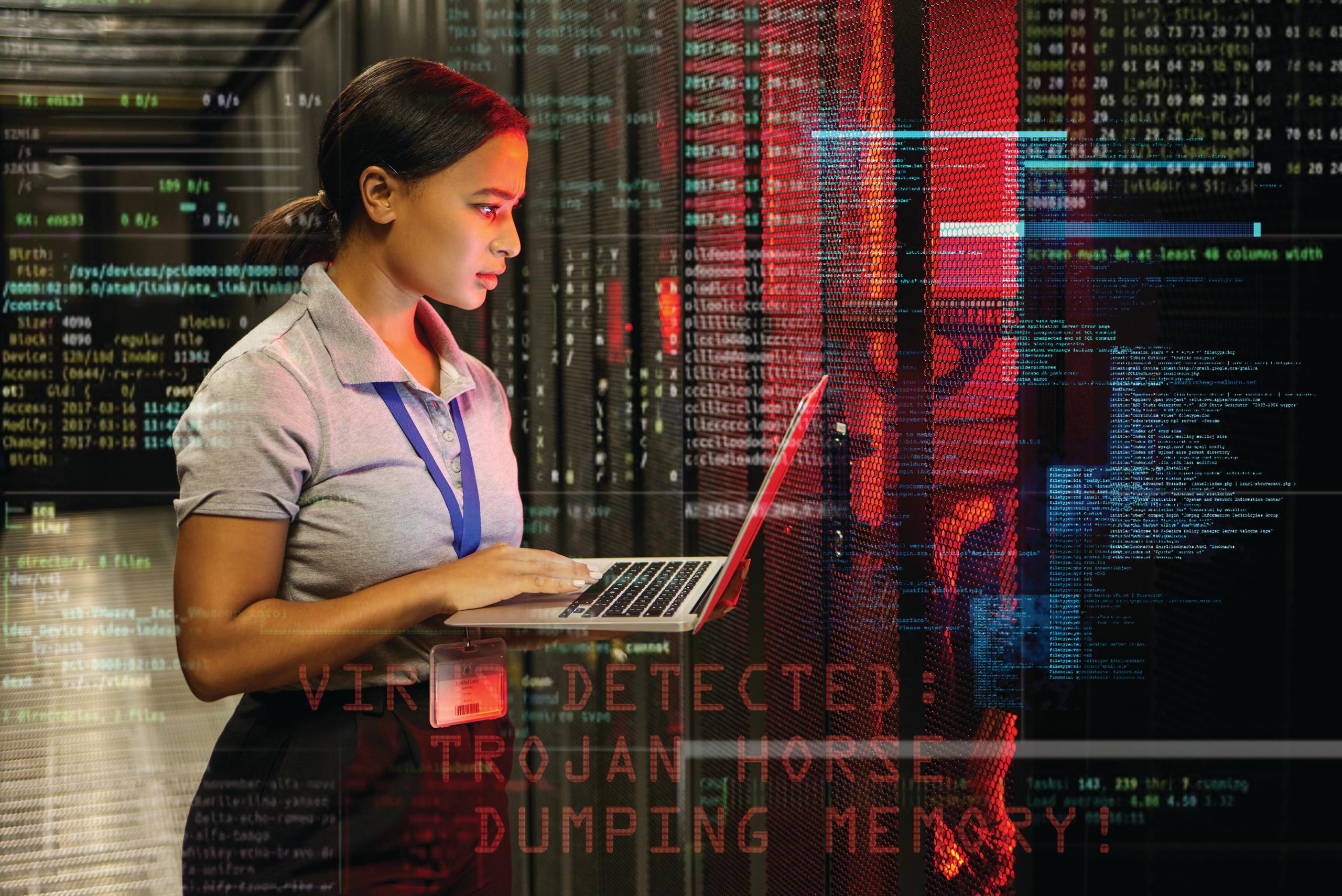This article aims to demystify cybersecurity for anyone in the plumbing business, spotlighting the invisible threats lurking in the digital shadows and offering a basic toolbox of preventive measures to safeguard your business against cyber predators.
In this digital transformation era, the traditionally resilient plumbing industry is adapting to the complex cybersecurity landscape. Small to medium-sized businesses (SMBs), the backbone of this industry, are not just installing smart devices like smart water heaters and Internet of Things (IoT)-enabled leak detection systems but are also embracing mobile technologies. With software and devices like GPS fleet tracking, augmented reality and handheld support tools, these businesses now have the tools they need to survive and thrive in a competitive business environment.
The notion that a plumbing business, with its pipes, wrenches and water heaters, could be the target of cyberattacks seems far-fetched to many. Yet, the reality is starkly different. Cybersecurity is not just a concern for the tech-savvy or the large corporations; it’s a critical battleground for businesses of all sizes, including your local plumber. Ignorance isn’t bliss; it’s a risk. A breach could mean the loss of sensitive customer information, financial turmoil or even the complete shutdown of operations.
As the plumbing industry embraces technological advancements, it becomes vulnerable to cybersecurity threats. Even unsophisticated hackers can exploit these new weaknesses, potentially leading to data breaches and significant operational disruptions—risks many in the field still do not fully understand.
The Real Threat: Cybersecurity Trends Affecting the Plumbing Sector
Smart Devices: The Double-Edged Sword
The integration of IoT devices in plumbing and HVAC systems has transformed operational efficiency and customer service. However, these devices often come with zero to minimal cybersecurity protections, making them easy targets for cybercriminals. A compromised smart thermostat or a connected water heater can serve as a gateway for attackers to infiltrate your business network, leading to data breaches and loss of customer trust.
Did You Know? One of the latest methods attackers use to gain access to an organization is through networked printers.
The Third-Party Platform Peril
Plumbing businesses rely on tools like software for scheduling, customer management and accounting, which pose a potential risk. While essential for modern business operations, these platforms can act as backdoors for cybercriminals if not adequately secured. A breach here can expose sensitive information, disrupt business operations and potentially lead to significant financial and reputational damage.
Did You Know? More than 50% of businesses have experienced a data breach through third-party platforms.

Micro Stories: Real-Life Cyber Scenarios
The Case of the Compromised Customer Email
John owns a small plumbing service in town and runs a tight ship with four plumbers on staff and a good IT team behind him to support his services. One day, he received an email from what appeared to be a regular customer asking for an urgent plumbing job. John clicked on the link provided to view the job details without hesitation. When the customer didn’t respond, he continued his daily business, unaware he had inadvertently downloaded malware. The hacker remained in his network for months, watching and collecting data. Eventually, John was locked out of his business accounts, and a ransom was demanded to release his data. This incident disrupted his operations and put his customers’ information at risk.
In today’s fast-paced digital world, the combination of human error and the need for constant vigilance in daily tasks, along with regular updates on the latest strategies, is not just important but crucial. These ongoing efforts can significantly enhance your defense against cybersecurity threats.
Smart Devices, Smarter Security
Sarah, who manages a family-owned HVAC and plumbing business, recently integrated smart thermostats into her office to improve energy efficiency. However, a few weeks after installation, she noticed an unexpected slowdown in her network performance. It turned out that the smart thermostats had been compromised and were being used to infiltrate her business network. This incident led to the exposure of sensitive client data and brought significant stress and financial strain to her business. Sarah’s experience underscores the critical need to ensure that all new devices are securely configured and regularly monitored to protect network integrity.
Real-Life Caution: A New Device, A New Vulnerability
Imagine a day at your plumbing business when you introduce a new tablet to help your technicians with on-the-job tasks. One busy morning, a technician uses this tablet to access customer information and job details while on site. Unknowingly, the tablet connects to an unsecured network.
When the technician returns to the office to complete the billing paperwork, a critical question looms: did connecting to an unsecured network compromise the data stored on the device? More importantly, when I connect to the company network, am I putting every device that connects to my network at risk?
This scenario highlights the often-overlooked vulnerabilities devices used off the network to access company data can impact your business. It emphasizes the need for robust cybersecurity measures that adapt to every change within your tech landscape.

Self-Defense: Simple Cybersecurity Measures
Even without a dedicated IT department, there are proactive steps you can take:
- Educate Your Team: Make sure everyone knows the basics of cybersecurity. Simple habits like verifying email senders can prevent many attacks.
- Use Strong, Unique Passwords: And change them regularly.
- Keep Software Updated: Regular updates close security loopholes.
- Secure Your Smart Devices: Change default passwords and regularly check device settings.
Signs of Trouble: Recognizing a Breach
Your business might be under attack if you notice:
- Sudden file changes: If files are modified without your action, it’s time to investigate.
- Locked accounts: Suddenly, can’t access your accounts? This action could be a hacker’s doing.
- Slow device or network performance: A sluggish system can often signal malware-consuming resources.
- Unusual account activity: Strange messages or requests? Your account might be compromised.
- You or someone in your business receives a strange message: Did you or anyone in your business accidently click on a link or open an email they are concerned about? It’s time to investigate.
In Case of Emergency: Responding to a Breach
- Contain the breach: Disconnect affected systems from the network to prevent further damage.
- Assess the situation: Identify what data was compromised and how the breach occurred.
- Notify affected parties: Transparency builds trust. Inform your customers and advise them on protecting themselves.
- Review and improve: Learn from the incident. Update and prioritize your security measures to help prevent future attacks.
Navigating the Currents of Compliance and Cybersecurity Insurance
Today it’s next to impossible to run any business without using digital tools. From online scheduling software to mobile payment processing, the need for stringent cybersecurity measures has never been greater.
The Importance of PCI Compliance
Payment Card Industry Data Security Standard (PCI DSS) compliance isn’t merely a requirement; it’s an essential safeguard for any business accepting card payments. Plumbing companies must ensure that every card transaction and the handling of cardholder data meets rigorous security standards to maintain trust and protect sensitive information.
PCI compliance is mandated for any business that processes, stores or transmits credit card information.
Given that payment card data is one of the most commonly breached types of data, responsible for an alarming 37% of all breaches, the stakes are high. Failure to comply can lead to severe penalties and a tarnished reputation should a data breach occur.

The Role of Cyber Insurance
The FBI warns it’s not a question of “if” but “when” a breach will occur. Cyber insurance emerges as a vital component of a plumbing business’s risk management strategy. A robust cyber insurance policy can offer a lifeline by covering fines, penalties or assessments related to non-compliance with PCI DSS in case of a data breach. Additionally, it can cover forensic costs, customer notifications and even the costs associated with credit monitoring for affected consumers. For businesses that experience chargebacks or need to recover funds from fraud, some policies extend to cover these financial setbacks. In many cases, due to the time it takes to recover and repair your business from a cyberattack, cyber insurance is the difference between survival of an event and a closing business.
Bridging the Gap: The Crucial Distinction Between IT and Cybersecurity Services
While many SMBs may rely on their IT staff for technical needs, ranging from managing active directory and network infrastructure to supporting end-user devices, it is a common misconception IT professionals can also address the company’s cybersecurity needs. The skillsets required for effective cybersecurity are distinct and do not necessarily overlap with those of general IT services. These skill differences create a critical gap where businesses believe they are adequately protected against cyber threats when, in fact, vulnerabilities still need to be addressed.
Some SMBs employ managed service providers (MSPs) to handle IT needs. However, not all MSPs prioritize cybersecurity within their service offerings. This oversight can leave SMBs exposed to potential threats. In the event of a security breach, the MSP may lack the necessary expertise to contain, eliminate and remediate the incident effectively, leading to significant risks. This emphasizes the need for services specifically focusing on cyber threats.
Even businesses that engage in managed IT and managed cybersecurity services become complacent. Without regular third-party audits to verify all protective measures and management practices are functioning at the highest standard, businesses cannot be truly confident in their cybersecurity posture. Audits are essential to ensure that the comprehensive security strategies believed to be in place are being executed and are effective.
The Solution: Ensuring Vigilance and Verification
Prioritizing cybersecurity, maintaining active partnerships with cybersecurity specialists and conducting regular third-party reviews and assessments are essential to ensuring your business’s cybersecurity measures remain current and effective. Partnering with experts who specialize in cybersecurity enhances these efforts, helping pinpoint potential vulnerabilities in the security infrastructure and demonstrating dedication to protecting your data and systems from cyber threats.
Next Steps and Resources
Taking Action: Your Cybersecurity Checklist
Start with a cybersecurity assessment to identify vulnerabilities in your current setup and serve as the foundation of your checklist and go-forward strategy. Next, prioritize the implementation of strong passwords and two-factor authentication across your systems. Engage a cybersecurity consultant to help develop a comprehensive security plan with technology and training components. Finally, visit resources like the Federal Trade Commission’s cybersecurity section for small businesses, which offers guides and tips for small enterprise needs.
Ready to Secure Your Business?
In a world where cyber threats loom larger every day, taking charge of your cybersecurity is not just wise—it’s essential. Don’t wait for a breach to realize the value of your data and the importance of protecting it. Start by reviewing current security practices, educating your team and implementing the simple measures we’ve discussed. Remember, safeguarding your business against cyber threats is a continual process, but you don’t have to do it alone. Reach out to cybersecurity professionals who can guide you through this journey, ensuring your business remains resilient in the face of digital dangers. Secure your future by acting now. Your company, customers and peace of mind are worth it.
Additional Resources:

Jason Bowra
Secur-Serv continues a decades-long relationship with IMARK and its members. The company has assisted numerous IMARK members in resolving their IT and cybersecurity challenges. Secur-Serv is a security-first managed services provider placing security at the center of everything it does. The company provides managed IT, cybersecurity, managed device and managed print services to companies of every size across the United States. With more than 2,000 field service technicians, a Network Operating Center based in Omaha, Nebraska, and extensive service offerings, Secur-Serv is a leading MSP for all things IT. Discover more about the synergistic partnership between IMARK and Secur-Serv by visiting https://secur-serv.com/imark/ or contact Brendan Whelton at Brendan.Whelton@scantron.com.